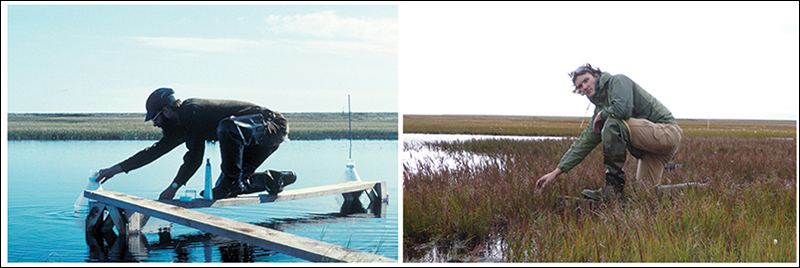Climate change has caused a boom in aquatic plant biomass on the Arctic tundra in recent decades. Those plants, in turn, are releasing increasing amounts of methane into the atmosphere, according to a paper published last week in the journal Global Change Biology.
Andresen and his colleagues didn’t have a time machine, but they had the next best thing.
Christian Andresen of Los Alamos National Laboratory in Los Alamos, N.M. and his colleagues suspected that longer growing seasons and increasing permafrost thaw were altering the ecology of small freshwater ponds that pepper the tundra landscape—and perhaps the amount of methane they give off. Without a time machine, however, it’s hard to go back and see just how ecosystems and their greenhouse gas dynamics have been affected on a local scale. Andresen and his colleagues didn’t have a time machine, but they had the next best thing.
Then and Now
A multinational project in the late 1960s and early 1970s called the International Biological Program (IPB) collected detailed data on major ecological communities around the world, including the Alaskan tundra. IPB researchers weren’t working with climate change in mind, but the data they gathered have provided Andresen and his colleagues with a unique window onto the state of the tundra ecosystem decades ago.
The methane flux from Alaskan wetlands has increased by about 60%.
The IPB data didn’t include information on methane, so Andresen and his colleagues developed a mathematical model to determine how such factors as vegetation biomass and thaw depth correlate with the amount of methane released today. By plugging the ecological data collected in the 1970s into the model, they could estimate the methane flux at that time.
Their results show that the biomass of grasses and sedges growing in tundra ponds has increased by 20% to 25% since the IPB era, primarily because of longer growing seasons and the increased availability of nutrients released from the thawing permafrost. During the same time period, Andresen and his colleagues estimate, the methane flux from these wetlands has increased by about 60%. Wetland plants that cover just 5% of the tundra’s surface may account for as much as two thirds of the region’s methane flux, the researchers estimate.

Methane Straws
Warmer conditions in the Arctic don’t lead to increased methane flux on their own. The new study confirmed that aquatic grasses and sedges act like straws, drawing methane up from the anoxic muck at the bottom of a pond and releasing it through their leaves before it can be converted to carbon dioxide.
“If methane’s only path to the atmosphere is through the soil, then the likelihood of a methane molecule being oxidized before it makes it to the atmosphere is very high,” said Joe von Fischer of Colorado State University in Fort Collins, an expert on ecosystem function and methane flux who was not involved in the study. “The presence of these plants as conduits for methane is fascinating.”
Blowing in the Wind?
Estimating greenhouse gas emissions across large land areas is complex, and not all measurements agree with Andresen’s findings. A paper published earlier this summer in Geophysical Research Letters about long-term atmospheric measurements taken at the tip of the Barrow peninsula concluded that Arctic methane flux has not increased significantly in the past 30 years. Since wetland plants cover only 5% of the landscape, “on the other 95%, there might be other biochemical processes offsetting our increase in methane,” said Andresen. He also suspects that atmospheric measurements, which are subject to changes in wind direction, may not capture the full picture of Arctic emissions.
Feedback Fret
Andresen, who began the study when he was a graduate student at the University of Texas at El Paso, and his colleagues are concerned that the trends they observed could create a positive feedback loop. “Warmer temperatures in this region have made the plants happier, and in addition to that, the permafrost is thawing,” said Andresen. “All those nutrients that have been stored for hundreds of years have been leached into these ponds.” More decomposing organic material at the plants’ roots means more methane emission, he reasoned—which, in turn, could accelerate climate change even further.
—Rebecca Heisman, Freelance Science Journalist; email: [email protected]
Correction, 23 September 2016: An earlier version of this article provided an incorrect affiliation for the lead author of the study. This article has been updated with the correct information.
Citation:
Heisman, R. (2016), Aquatic plants may accelerate Arctic methane emissions, Eos, 97, https://doi.org/10.1029/2016EO059769. Published on 22 September 2016.
Text © 2016. The authors. CC BY-NC-ND 3.0
Except where otherwise noted, images are subject to copyright. Any reuse without express permission from the copyright owner is prohibited.

